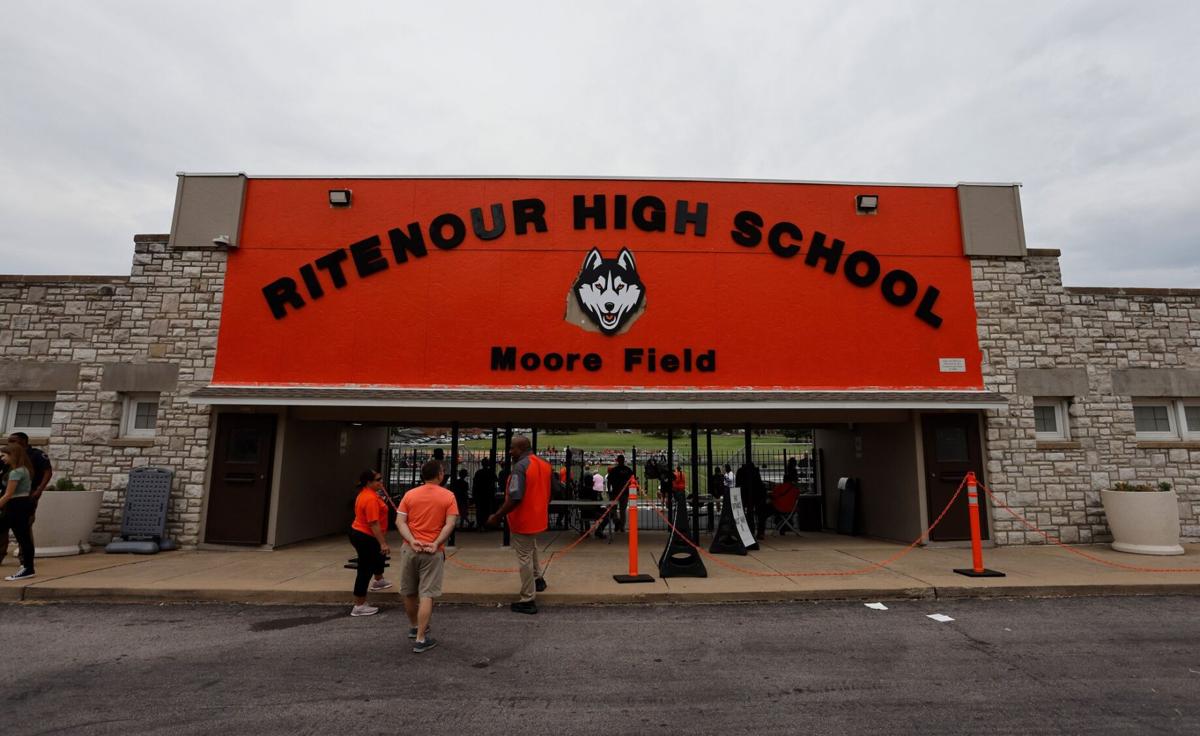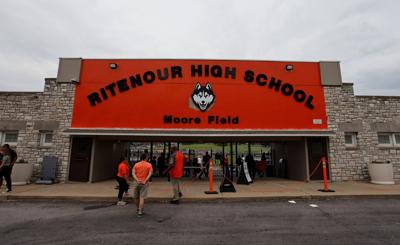ST. LOUIS ÔÇö Around 1 a.m. on Thursday, Sept. 26, an Instagram account called ÔÇ£schoolshooter314and618ÔÇØ posted a picture of two large rifles and threatened serious damage.
kAm%96 42AE:@? =:DE65 D:I 5:776C6?E D49@@=D 7@==@H65 3J 52E6D[ :?4=F5:?8 ÔÇ£w2K6=H@@5 62DE h^ae]]] y6??:?8D w:89 D49@@= `_^`j '2D9@? `_^a]ÔÇØk^Am
kAm$E] {@F:D r@F?EJ A@=:46 EC24<65 5@H? E96 4C62E@C @7 E96 244@F?E[ `g\J62C\@=5 $62? $4@EE[ 2?5 96ÔÇÖD D:?46 366? 492C865 H:E9 >2<:?8 2 7:CDE\568C66 E6CC@C:DE E9C62E[ 2 76=@?J]k^Am
kAmÔÇ£w6 5:5 :E <?@H:?8 :E H@F=5 A=246 E9@FD2?5D @7 A6@A=6 :? 762C 3642FD6 96 H2D 3@C65 2?5 5:5 ?@E H2?E E@ 8@ E@ D49@@=[ÔÇØ 4@FCE C64@C5D D2:5]k^Am
kAm#6A@CED @7 D:>:=2C E9C62ED 282:?DE D49@@=D[ >@DE=J 9@2I6D[ 92G6 7=@@565 ?2E:@?2= ?6HD C6A@CED :? C646?E H66<D 2?5 >@?E9D] $49@@=D :? E96 $E] {@F:D C68:@? 92G6 k2 9C67lQ9EEADi^^HHH]DE=E@52J]4@>^?6HD^=@42=^4C:>6\4@FCED^49:=5C6?\A2C6?ED\492C865\2D\A@=:46\4C24<\5@H?\@?\D49@@=\E9C62ED\E96J\E9:?<\E9:D\:D\7F??J^2CE:4=60a_ag4e4c\fffb\``67\h7`6\57a4daf365ae]9E>=Q E2C86ElQ03=2?<Qm72465 2E =62DE b_ E9C62EDk^2m @G6C E96 A2DE EH@ H66<D 2=@?6]k^Am
kAmx? E96 ?@H 86?6C2E:@?\=@?8 H2<6 @7 E96 `hhh r@=F>3:?6 D49@@= D9@@E:?8 :? r@=@C25@[ D49@@= =6256CD 2C6 ?@ =@?86C ;FDE E2D<65 H:E9 AC@G:5:?8 2 BF2=:EJ 65F42E:@?] %96J ?@H >FDE 6?DFC6 E96:C DEF56?ED 2?5 6>A=@J66D 2C6?ÔÇÖE 92C>65 2E D49@@=]k^Am
kAm$@ E96J E2<6 6G6CJ E9C62E ÔÇö C682C5=6DD @7 H96E96C :EÔÇÖD 2? :==\4@?46:G65 D@4:2= >65:2 ÔÇ£;@<6ÔÇØ ÔÇö D6C:@FD=J] p?5 D64FC:EJ 2?5 AC6A2C2E:@?D 7@C E96 H@CDE\42D6 D46?2C:@ 92G6 364@>6 A2CE @7 D49@@= 2C49:E64EFC6]k^Am
kAm|6E2= 56E64E@CD[ 3F==6EAC@@7 8=2DD[ DFCG6:==2?46 E649?@=@8J[ 42>6C2D[ 2=2C> DJDE6>D 2?5 D276EJ @77:46CD 2C6 ?@H 4@>>@?] $@ E@@ 2C6 24E:G6\D9@@E6C 5C:==D 2?5 4@?E:?86?4J A=2?D E@ 9:56 7C@> 2?5 4@?E2:? 2?J >2DD D9@@E:?8]k^Am
kAm$@ 72C :? a_ac[ E96C6 H6C6 2E =62DE `bh :?4:56?ED @7 8F?7:C6 @? D49@@= 8C@F?5D[ C6DF=E:?8 :? ca 562E9D 2?5 h` :?;FC:6D[ k2 9C67lQ9EEADi^^HHH]6G6CJE@H?]@C8Q E2C86ElQ03=2?<QmtG6CJ%@H? 7@C vF? $276EJ C6A@CEDk^2m]k^Am
kAm#:E6?@FC D49@@=D $FA6C:?E6?56?E r9C:D z:=3C:56 92D DE2CE65 E@ =@D6 4@F?E @7 E96 E9C62ED]k^Am
kAmx? 9:D D49@@= 5:DEC:4E[ :E DE2CE65 (65?6D52J[ $6AE] ``[ H:E9 2? 2?@?J>@FD D@4:2= >65:2 A@DE E9C62E6?:?8 #:E6?@FC w:89 $49@@=] %96? 2?@E96C H2D A@DE65] p5>:?:DEC2E@CD 2?5 A@=:46 :?G6DE:82E65 :?E@ E96 62C=J 9@FCD @7 $6AE] `a E@ 56E6C>:?6 H96E96C :E H2D 4C65:3=6]k^Am
kAm%96 D49@@= H6?E E@ G:CEF2= 4=2DD6D E96 ?6IE 52J[ ;FDE E@ 36 D276]k^Am
kAm%9C@F89@FE E96 ?6IE H66<[ #:E6?@FC A2C6?ED C646:G65 2=>@DE 52:=J ?@E:7:42E:@?D @7 E9C62ED >256 2?5 E9C62ED E9H2CE65 @C 566>65 F?4C65:3=6] ~?6[ >256 3J 2 >:55=6 D49@@= DEF56?E 5FC:?8 4=2DD[ :?G@=G65 2 h`` 42== 72=D6=J 4=2:>:?8 E96C6 H2D 2 D9@@E6C 2E E96 D49@@=]k^Am
kAm%96 H@CDE 2=>@DE 92AA6?65 @? $6AE] `f[ H96? $E] p?? A@=:46 D2:5 2 `e\J62C\@=5 7@C>6C DEF56?E A@DE65 2 G:56@ @7 9:>D6=7 @? x?DE28C2> H2G:?8 2 8F? 2C@F?5 2?5 E288:?8 #:E6?@FC w:89] %96 E66?[ 2C>65 H:E9 2 v=@4< 2?5 2? 6IE6?565\C@F?5 >282K:?6[ H2D 2CC6DE65 @? D49@@= 8C@F?5D 2?5 492C865] w:D A2C6?ED ?@H 7246 492C86D 7@C 2==6865=J ECJ:?8 E@ 9:56 6G:56?46 k2 9C67lQ9EEADi^^HHH]DE=E@52J]4@>^?6HD^=@42=^4C:>6\4@FCED^A2C6?ED\@7\7@C>6C\C:E6?@FC\DEF56?E\244FD65\@7\E9C62E6?:?8\D49@@=\724:?8\E2>A6C:?8\492C86^2CE:4=60cffdbbde\fe42\``67\gfgb\f7f4a22cd74d]9E>=Q E2C86ElQ03=2?<Qm282:?DE 9:>k^2m]k^Am
kAmÔÇ£%9:D :D ?@E D@>6E9:?8 E92E H6 D9@F=5 364@>6 D@ 256AE 2E 562=:?8 H:E9[ÔÇØ z:=3C:56 E@=5 2 4C@H565 C@@> @7 C6A@CE6CD 2E 2 ?6HD 4@?76C6?46 =2E6C E92E 52J]k^Am
kAmqFE E96J 92G6 364@>6 256AE]k^Am
kAmÔÇ£(6 2=H2JD 92G6 E@ 2DDF>6 E92E 2?JE9:?8 42? 92AA6? 2E 2?J E:>6[ÔÇØ z:=3C:56 D2:5 :? 2? :?E6CG:6H] ÔÇ£p?5 E96 F?7@CEF?2E6 C62=:EJ 2C@F?5 E96 4@F?ECJ[ D@>6E9:?8 H:==]ÔÇØk^Am
kAm%96 A2DE 76H H66<D 92G6 366? C@F89 @? #:E6?@FCÔÇÖD DEF56?ED 2?5 DE277[ z:=3C:56 D2:5] pD E96 A6CD@? E2D<65 H:E9 =625:?8 E96 5:DEC:4E E9C@F89 E96 DA2E6 @7 E9C62ED[ z:=3C:56 D2:5 :EÔÇÖ5 36 62DJ E@ 766= @G6CH96=>65[ 3FE :?DE625[ 96 766=D AC@F5] w6 D2:5 9:D 4@>>F?:EJ 92D 4@>6 E@86E96C E9C@F89 E9:D 5:77:4F=E E:>6]k^Am
kAmÔÇ£p?5 x <?@H :EÔÇÖD ?@E 8@:?8 E@ 8@ @? 7@C6G6Cj x <?@H E96C6ÔÇÖD 8@:?8 E@ 36 2 =@E @7 =62C?:?8 23@FE E96 C@@E 42FD6D E92EÔÇÖD 42FD65 E9:D DA:<6[ÔÇØ z:=3C:56 D2:5]k^Am
k9amÔÇÿp ac^f @A6C2E:@?ÔÇÖk^9am
kAm~4E] ac >2C<D EH@ J62CD D:?46 2? 2C>65 :?ECF56C D9@E E96 8=2DD @FE @7 2 5@@C 2E k2 9C67lQ9EEADi^^HHH]DE=E@52J]4@>^?6HD^=@42=^>6EC@^2\BF:6E\>@C?:?8\E96?\D4C62>D\2?5\3F==6ED\9@H\E96\DE\=@F:D\D49@@=\D9@@E:?8\F?7@=565^2CE:4=60bc``a``_\bha7\d6_a\ga5g\he6f34d64g6_]9E>=Q E2C86ElQ03=2?<Qmr6?EC2= ':DF2= 2?5 !6C7@C>:?8 pCED w:89 $49@@=k^2m 2?5 =6E 9:>D6=7 :? 2?5 <:==65 DEF56?E p=6IK2?5C:2 q6== 2?5 E62496C y62? zF4K<2]k^Am
kAm%96 EC2865J 5C@G6 D49@@= =6256CD E@ 6I2>:?6 E96:C @H? A6C:>6E6CD] pD 5:5 D6G6C2= @E96C D9@@E:?8Di !2C<=2?5[ $2?5J w@@<[ &G2=56[ r@=F>3:?6[ E@ ?2>6 @?=J 2 76H]k^Am
kAm|F=E:A=6 5:DEC:4ED ÔÇö :?4=F5:?8 #:E6?@FC[ {:?536C89[ |69=G:==6 2?5 uC2?4:D w@H6== ÔÇö 92G6 3F:=E D64FC:EJ G6DE:3F=6D[ @C D>2==[ 6?4=@D65 DA246D E92E D6CG6 2D 2 5@F3=6\32CC:6C 2E 6?EC2?46D 2?5 C6BF:C6 2 A6CD@? :?D:56[ @7E6? 4@??64E65 3J 2 42>6C2 @C DA62<6C[ E@ 2==@H 6?ECJ E@ G:D:E@CD]k^Am
kAmu6C8FD@?\u=@C:DD2?E[ 2>@?8 @E96C 5:DEC:4ED[ DE2CE65 FD:?8 2 >@?:E@C:?8 D@7EH2C6 E@@= 42==65 $64FC=J E92E 56E64ED F?D276 24E:G:EJ @?=:?6] xE 7=28D H@C5D DF49 2D ÔÇ£D9@@E[ÔÇØ ÔÇ£<?:76[ÔÇØ ÔÇ£8F?ÔÇØ 2?5 ÔÇ£DF:4:56ÔÇØ :7 2 DEF56?E EJA6D E96> 2?5 2=6CED D64FC:EJ[ 4@F?D6=@CD 2?5 D49@@= =6256CD]k^Am
kAmÔÇ£q2D65 @? E96 =6G6= @7 C:D<[ E96C6 92G6 366? :?DE2?46D H96? H6 92G6 2D<65 E96 A@=:46 E@ 4@?5F4E 2 4964< 2E 2 DEF56?EÔÇÖD 9@>6[ÔÇØ 5:DEC:4E DA@<6DA6CD@? ~?J6 w@==@>@? D2:5] ÔÇ£z66A:?8 D49@@=D D276 :D 2 ac^f @A6C2E:@?]ÔÇØk^Am
kAm{2DE J62C[ #@4<H@@5 $49@@= s:DEC:4E 9:C65 7@FC D49@@= D276EJ @77:46CD E@ 96=A A2EC@= 6=6>6?E2CJ D49@@=D] t249 AC6G:@FD=J D6CG65 2D 2 #@4<H@@5 D49@@= C6D@FC46 @77:46C 2E D@>6 A@:?E :? E96:C 42C66CD[ 2 DA@<6DA6CD@? D2:5] %96JÔÇÖC6 2C>65]k^Am
kAm}@C>2?5J $49@@=D r@==23@C2E:G6 92D DA6?E >@C6 E92? Sc__[___ @? D276EJ 7@C E96 a[g__\DEF56?E 5:DEC:4E @G6C E96 A2DE J62C] %9:D :?4=F565 D42??6CD[ DFCG6:==2?46 DJDE6> FA8C256D 2?5 >6E2= 56E64E@CD 2E >:55=6 2?5 9:89 D49@@=D] vC256D D:I 2?5 FA ?@H C6BF:C6 4=62C 3@@< 328D[ 2?5 DEF56?ED >FDE AFE E96:C A9@?6D :? =@4<65 A@F496D 5FC:?8 E96 D49@@= 52J]k^Am
kAm|F=E:A=6 5:DEC:4ED 92G6 2=D@ DE2CE65 E@ EC2:? DE277 9@H E@ C64@8?:K6 6>6C86?4J 3=665:?8 2?5 9@H E@ DE@A :E[ 6:E96C 3J 2AA=J:?8 E@FC?:BF6ED @C A24<:?8 H@F?5D[ E9C@F89 <:ED 42==65 k2 9C67lQ9EEADi^^HHH]DE@AE963=665]@C8Q E2C86ElQ03=2?<Qm$E@A E96 q=665k^2m]k^Am
kAmp?5 =@42= D49@@=D 92G6 4@==64E:G6=J DA6?E >:==:@?D @? 3F==6EAC@@7 8=2DD :? 6?EC2?46D @C 92==H2JD] x? yF?6[ E96 {25F6 $49@@= s:DEC:4EÔÇÖD 3@2C5 2AAC@G65 DA6?5:?8 Sedd[___ E@ :?DE2== 7@C465\6?ECJ\C6D:DE2?E[ C:@E\ 2?5 3F==6E\C6D:DE2?E D64FC:EJ =2>:?2E6D @? D6=64E H:?5@HD 2?5 5@@CD 2E 2== 6:89E @7 E96 5:DEC:4EÔÇÖD D49@@=D]k^Am
kAm$E] {@F:D !F3=:4 $49@@=D 5:5 ?@E C6DA@?5 H96? 2D<65 H92E D276EJ :>AC@G6>6?ED H6C6 >256 E@ r6?EC2= ':DF2= 2?5 !6C7@C>:?8 pCED w:89 $49@@= D:?46 E96 a_aa D9@@E:?8] qFE 2E 2 ?6HD 4@?76C6?46 k2 9C67lQ9EEADi^^DA64ECF>=@42=?6HD]4@>^>@^DE\=@F:D^?6HD^a_ac^_f^ah^>:==:@?D\@7\5@==2CD\A=2??65\7@C\D276EJ\2?5\D64FC:EJ\:>AC@G6>6?ED\7@C\4GA2\\@E96C\D=AD\D49@@=DQ E2C86ElQ03=2?<Qm:? yF=Jk^2m[ q@2C5 @7 t5F42E:@? ':46 !C6D:56?E |2EE s2G:D D2:5 >:==:@?D 92G6 8@?6 E@H2C5 D276EJ 2?5 D64FC:EJ FA8C256D]k^Am
kAm%96 !2C<H2J $49@@= s:DEC:4E ?@H FD6D 2 E9C62E 2DD6DD>6?E >@56= 32D65 @? 8F:56=:?6D k2 9C67lQ9EEADi^^HHH]D49@@=E2]4@>Q E2C86ElQ03=2?<Qm7@C>65 3J 2 C6D62C496Ck^2m 2E E96 &?:G6CD:EJ @7 ':C8:?:2 E92E 96=AD :56?E:7J 2?5 255C6DD E9C62ED[ 2D H6== 2D E96 F?56C=J:?8 :DDF6D E92E =65 E@ E96>] t249 !2C<H2J D49@@= 6G2=F2E6D 6249 E9C62E[ :? 255:E:@? E@ :56?E:7J:?8 DEF56?ED H9@ >2J 36 DECF88=:?8 E@ :?E6CG6?6 62C=J D@ E92E G:@=6?E 3692G:@C 5@6D?ÔÇÖE @44FC :? E96 7:CDE A=246]k^Am
kAmÔÇ£$9@@E:?8 FA 2 D49@@= :D 6I4665:?8=J C2C6[ÔÇØ vC68 (286?6C[ 4@@C5:?2E@C @7 DEF56?E 5:D4:A=:?6 2?5 2=E6C?2E:G6 DEF56?E AC@8C2>D[ D2:5] ÔÇ£qFE :? ;FDE 23@FE 6G6CJ @E96C :?DE2?46[ :E H2D E96 6?5 C6DF=E @7 2 56E64E23=6 AC@46DD]ÔÇØk^Am
k9amÔÇÿ}@ AC:46ÔÇÖ 7@C D276EJk^9am
kAm':D:E@CD E@ {:?536C89 w:89 $49@@= >FDE DE2?5 367@C6 2 D64FC:EJ 42>6C2 2?5 DE2E6 E96:C 3FD:?6DD] p D64FC:EJ @77:46C H2E496D C6>@E6=J 7C@> 2 >@?:E@C]k^Am
kAm~?46 :?D:56 2? 6?ECJ G6DE:3F=6 =:?65 H:E9 8=2DD >256 E@ E2<6 D6G6C2= >:?FE6D E@ 3C62< E9C@F89[ 2? 2EE6?52?E E2<6D 5C:G6CÔÇÖD =:46?D6D 2?5 CF?D E96 ?2>6D E9C@F89 2 ?2E:@?2= D6I @776?56C C68:DECJ] ':D:E@CD 2AAC@G65 7@C 6?ECJ >FDE H62C 2 AC:?E65 DE:4<6C H:E9 E96:C ?2>6D 2?5 A9@E@D @? E96>]k^Am
kAm%9:D :D E96 ?6H {:?536C89 w:89 $49@@=[ H9:49 F?56CH6?E 2 D:8?:7:42?E C6?@G2E:@? 2?5 6IA2?D:@? @G6C E96 A2DE 7@FC J62CD]k^Am
kAm$276EJ H2D 2 <6J A2CE @7 E96 C6G2>A 2?5 :?4=F565 4@?DF=E2E:@? 7C@> D64FC:EJ 6IA6CE !9:= $2?E@C6[ H9@ H@C<65 @? E96 C63F:=5D @7 E96 (@C=5 %C256 r6?E6C :? }6H *@C< r:EJ 2?5 $2?5J w@@< t=6>6?E2CJ :? r@??64E:4FE]k^Am
kAmÔÇ£%96 4@?46AE :D E@ >2<6 J@FC 3F:=5:?8D C62==J 92C5 E@ 86E :?E@ 3FE ?@E 766= =:<6 2 AC:D@?[ÔÇØ D2:5 $FA6C:?E6?56?E %@?J {2<6]k^Am
kAm|2?J H:?5@HD 2C6 56D:8?65 E@ H:E9DE2?5 6?ECJ 7C@> 2?JE9:?8 7C@> 2 92>>6C E@ 2 8F?] x? D@>6 2C62D[ 9:89\:>A24E D966EC@4< =:?6D E96 H2==D]k^Am
kAmx7 D@>6@?6 5@6D 86E :?[ 4=2DDC@@>D 4@??64E G:2 324< 4@CC:5@CD E92E =625 E@ D276 C@@>D H:E9 ÔÇ£92C5 4@C?6CD[ÔÇØ H96C6 DEF56?ED H@F=5 36 @FE @7 2? :?ECF56CÔÇÖD =:?6 @7 D:89E] r6CE2:? 5@@CD 2C6 7:EE65 H:E9 E9F>3\EFC? =@4<D D@ E62496CD H@F=5?ÔÇÖE 92G6 E@ H@CCJ 23@FE 7:?5:?8 E96:C <6JD :? 2 4C:D:D]k^Am
kAm%96C6 2C6 @?=J EH@ H2JD :? 2?5 @FE] ~?=J E9@D6 H:E9 D64FC:EJ 32586D 42? FD6 @E96C 6?EC2?46D H:E9@FE D6EE:?8 @77 2=2C>D]k^Am
kAm%96 32586D 2C6 7:EE65 H:E9 2 A2?:4 3FEE@? E92E 42? 2=6CE =@42= A@=:46 @7 6>6C86?4:6D] %C2?D>:EE6CD E9C@F89@FE E96 D49@@= 4C62E6 2 ÔÇ£86@76?46ÔÇØ @7 E96 3F:=5:?8 2?5 E6== C6DA@?56CD 6I24E=J H96C6 :? E96 3F:=5:?8 2 E9C62E H2D C6A@CE65]k^Am
kAmtG6?EF2==J[ 6G6CJ {:?536C89 3F:=5:?8 H:== 92G6 2=2C> 5@@CD[ 255:E:@?2= D64FC:EJ 42>6C2D 2?5 D276EJ 7:=> @C 2 E9:? A=2DE:4 4@G6C:?8 @G6C H:?5@HD E92E AC@E64ED 282:?DE 3C62<\:?D] p== E92?<D E@ 2 3@?5 :DDF6 E92E A2DD65 :? pAC:=]k^Am
kAmÔÇ£x7 J@F DFCG6J 72>:=:6D C:89E ?@H[ @?6 @7 E96 3:886DE E9:?8D E92EÔÇÖD @? E96:C >:?5 :Di xD >J <:5 8@:?8 E@ 36 D276 2E D49@@=nÔÇØ {2<6 D2:5] ÔÇ£x 5@?ÔÇÖE E9:?< D276EJ 92D 2 AC:46]ÔÇØk^Am
kAmqFE 724:=:EJ FA8C256D 42? @?=J 5@ D@ >F49[ {2<6 D2:5]k^Am
kAm~? 2 C646?E D49@@= 52J[ 5FC:?8 {:?536C89ÔÇÖD ÔÇ£A@H6C =F?49ÔÇØ ÔÇö 2 d_\>:?FE6 7C66 A6C:@5 :? E96 >:55=6 @7 E96 52J ÔÇö DEF56?ED H6C6 >:?8=:?8 :? E96 D49@@=ÔÇÖD @A6? DA246Dj E96J H6C6 :? E96 8J>D A=2J:?8 32D<6E32==[ :? >FD:4 C@@>D AC24E:4:?8 G:@=:?[ :? 4=2DDC@@>D 86EE:?8 6IEC2 96=A 7C@> E62496CD]k^Am
kAm%96 8@2= :D 4@??64E:G:EJ[ {2<6 D2:5[ E@ 8:G6 DEF56?ED >@C6 E:>6 E@ ;@:? 4=F3D 2?5 D@4:2=:K6 2?5 96=A E96> 766= =:<6 D49@@= :D 2 D64@?5 9@>6]k^Am
kAmÔÇ£%96J 766= =:<6 E96J 36=@?8[ E96J 766= =:<6 E96JÔÇÖC6 H6=4@>6[ÔÇØ 96 D2:5] ÔÇ£%92EÔÇÖD @FC }@] ` D276EJ DEC2E68J]ÔÇØk^Am
View life in 51║┌┴¤ through the Post-Dispatch photographers' lenses. Edited by Jenna Jones.
Want to see more like this?
Get our local education coverage delivered directly to your inbox.






















